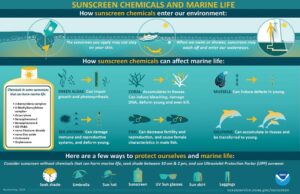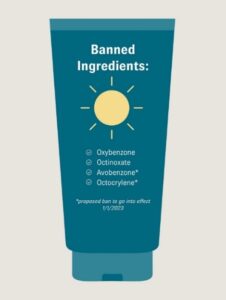Now that summer is here, it is important that we are wearing sunscreen to protect ourselves against harmful rays. However, it is also important to consider the environmental impacts at the same time.
It is estimated that approximately 14,000 tons of sunscreen enter our oceans each year; when we swim or jump into oceans or other waterways, some of the sunscreen we apply washes off into the water. It has also been found that even if you don’t swim after applying sunscreen, it can be washed down drains when you shower, eventually entering our waterways.
When we swim with sunscreen on, chemicals such as oxybenzone can enter waterways, where they’re then able to be absorbed by corals. These chemicals contain something called nanoparticles that can cause impacts such as disrupting coral’s reproduction and growth cycles, which can lead to coral bleaching.
The majority of sunscreen brands contain oxybenzone, which is a UV filtering compound that is harmful to the environment as it can be fatal to baby reefs and damaging to adult reefs (coral reefs host and home to more than 25% of all marine life [Source]). Other sunscreen ingredients (including oxybenzone) are also believed to cause other impacts such as those shown in the graphic below.

Marine life is important to us, as scientists have estimated that roughly half of the oxygen production on Earth comes from the ocean, with the majority of this production coming from oceanic plankton [Source]. As well as this, coral reefs are estimated to directly or indirectly support over 1 billion people worldwide from the ecosystem services they provide [source].
A further environmental concern about sunscreen is that it commonly comes in single-use plastic bottles, which often end up in landfill. Unfortunately, a lot of sunscreens also contain microplastics, which are then washed into our waterways and oceans, ultimately being ingested by marine life.
The world’s coral reefs and marine life are suffering, and chemicals and plastics commonly found in sunscreen contribute to the problem.
There are two kinds of sunscreen commonly available in stores and online:
Chemical (organic): Chemical sunscreens are the most commonly used sunscreen. They absorb and reduce UV rays’ ability to penetrate the skin. Ingredients in chemical sunscreens often include: Oxybenzone and Octinoxate.
Physical (mineral or inorganic): The second type of common sunscreens, sometimes marketed as ‘reef safe’, are less popular than chemical sunscreens but block or reflect both UVA and UVB rays. Ingredients in physical sunscreens often include: Zinc Oxide and Titanium Dioxide.
Some destinations, such as Hawaii and Palau, ban harmful sunscreens. The focus has been on two chemicals, the UV filters Oxybenzone and Octinoxate; Hawaii banned these UV filters in 2021 and Palau announced a ban in 2020.

When you are buying your next sunscreen, consider shopping more sustainably with these tips:
It is important to protect ourselves from UV rays but it is also important to understand that some sunscreens cause damage to marine life. It might not feel as though you are making a huge difference, but by making small changes to our everyday lives, we can reduce our environmental impact and make positive steps to supporting sustainability.
Interested in a discovery call to align your sustainability commitments? Get in touch with Lucy today.

Lucy Picken
Consultant Researcher
lucy.picken@actionsustainability.com

This was posted in All Topics, Biodiversity, Wellbeing
Consultant Hattie Webb dives into some practical tips to enable anyone to embrace sustainable traveling. From choosing eco-friendly destinations to minimising waste and respecting natural habitats, these tips aim to reduce the environmental impact of commuting while providing a more meaningful travel experience.
Read Article
This was posted in Biodiversity, Energy & Carbon, Sustainability Strategy
For Earth Day 2024, we asked our subject matter experts to share their perspectives on the key issues facing the planet and what actions are needed.
Read Article
This was posted in Biodiversity, Modern Slavery & Human Rights, Wellbeing
Consultant Hattie Webb sheds light on how our food choices directly contribute to a range of climate issues while also exposing the harsh realities of modern slavery in the chocolate and coffee industries.
Read Article